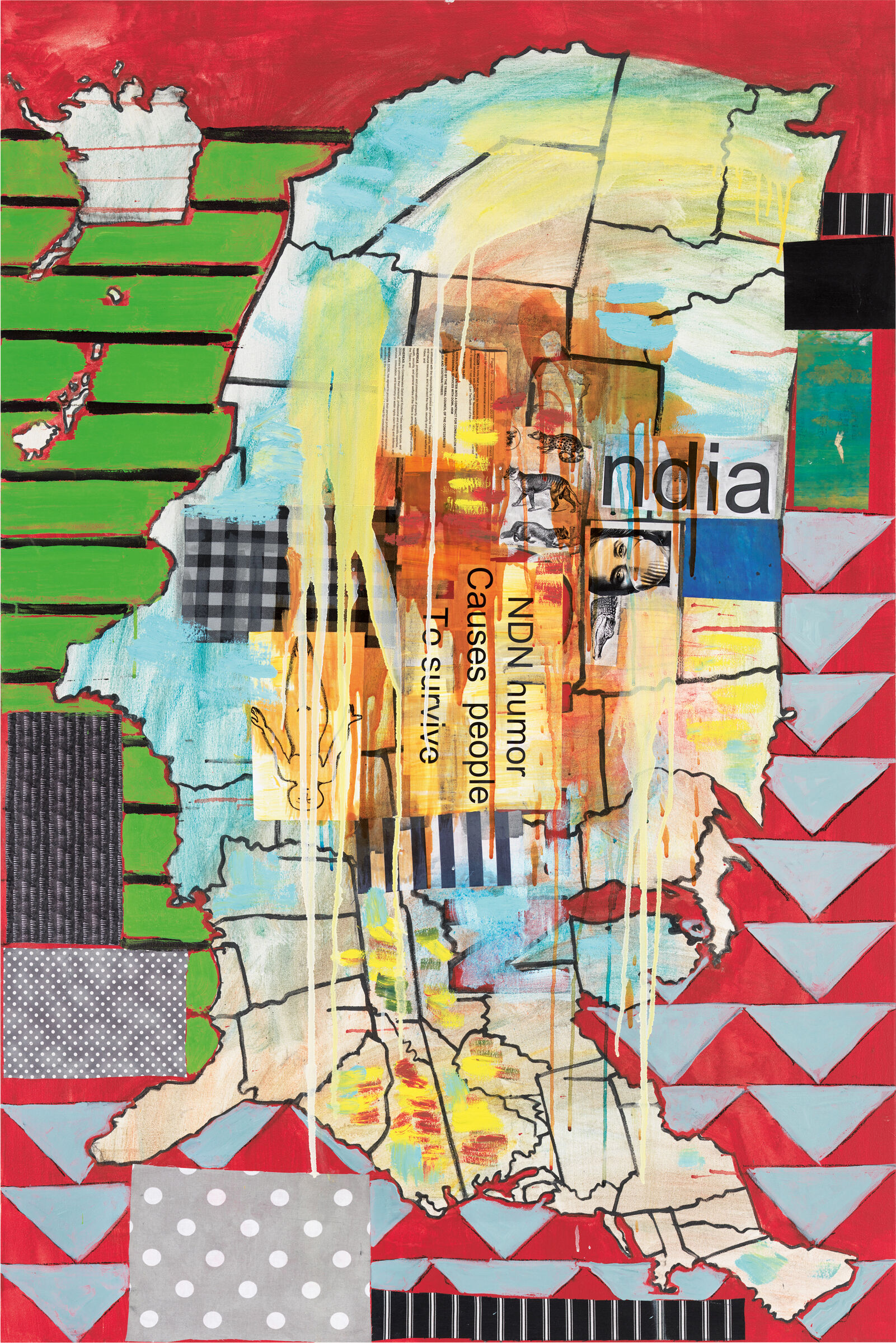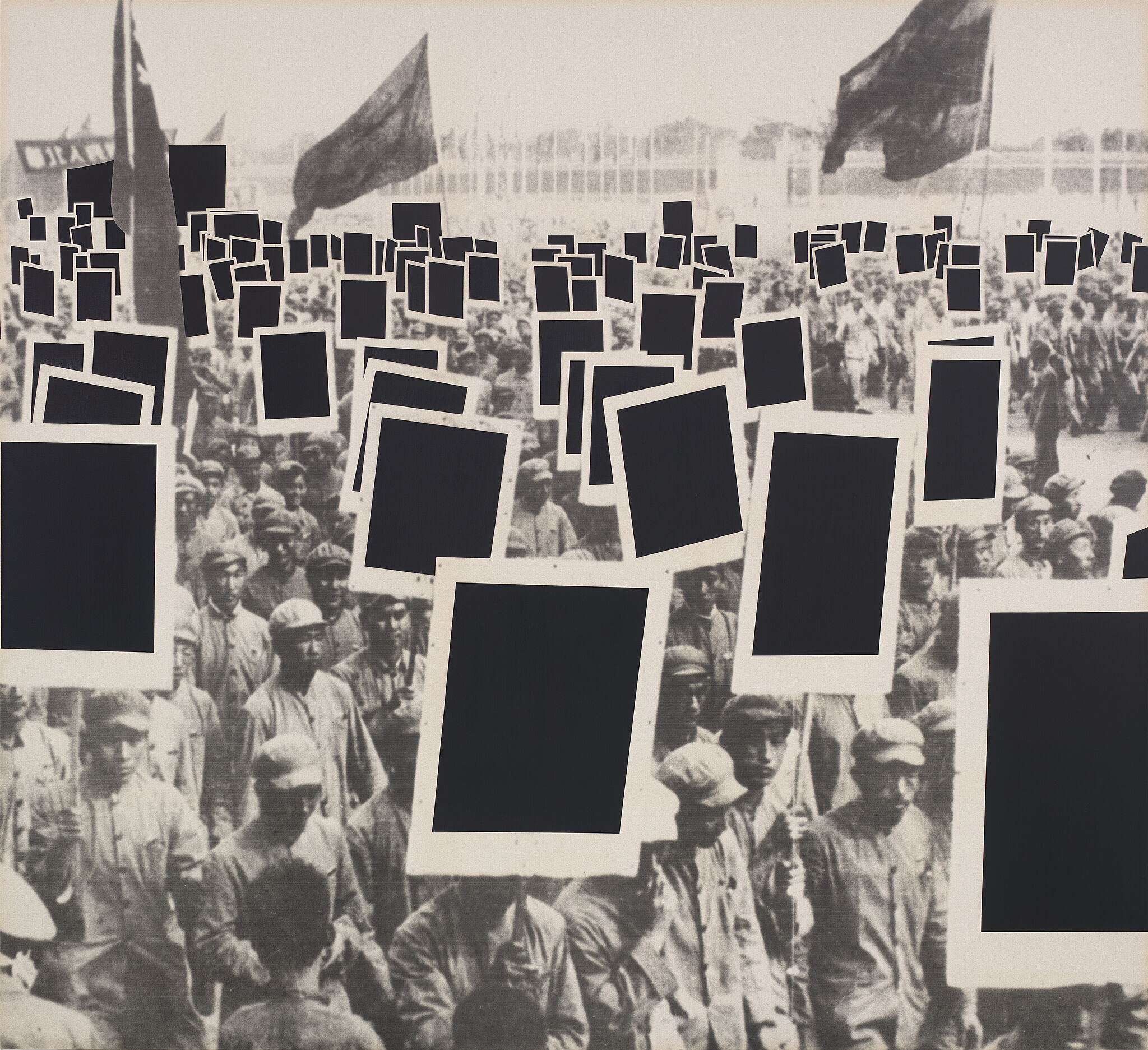Visual description
Celebrate 40,000 Years of American Art is a large vertical collagraph etching, 76 1/2 inches high by 53 inches wide. The work consists of several central dark figures with text at the top and bottom of the work. The figures are silhouettes in the shape of rabbits, drawn in a similar style as the Peterborough petroglyphs and they recede in size from largest at the right and smallest at the left, five total. Each rabbit is anthropomorphized, standing upright with long arms, legs and torso like a person. They have long faces, long rabbit ears pointed upwards, and a short pointed tail sticking out from the left side of their hips. They do not have distinguished features on their paws. Peeking out from behind the two largest rabbits and underneath text at the top of the image is a hazy and loosely drawn outline of a large rabbit with prominent ears in a more dynamic pose than the other rabbits with its arms and legs apart and whose body that blends into the dark hazy background.
Above the rabbits at the top of the image blocky text in a rounded font and in all caps reads “CELEBRATE 40,000 YEARS”, and text at the bottom of the image reads “OF AMERICAN ART”. The background has a smokey gritty gray texture, and the text along with the rabbit shapes are a deep, warm black. The image is speckled with water droplets with a sand-like texture. Throughout the grittiness, there are thin twisting trails of drips, and a cloudy haze of black and gray. The two largest rabbits also contain texture as they are speckled with light streaks against their black silhouettes. Quick-to-See Smith chose a rabbit here because of its popularity and recognition worldwide, and to pay homage to ancient rabbit petroglyphs.
Not on view
Date
1995
Classification
Prints
Medium
Collagraph
Dimensions
Sheet (Sight): 76 1/2 × 53 in. (194.3 × 134.6 cm)
Image (Sight): 71 1/2 × 47 5/16 in. (181.6 × 120.2 cm)
Accession number
2000.191
Edition
3/20
Publication
Printed and published by Island Press
Credit line
Purchase, with funds from The Horace W. Goldsmith Foundation
Rights and reproductions
Courtesy the artist and the Garth Greenan Gallery, New York
Audio
-
0:00
Verbal Description: Celebrate 40,000 Years of American Art, 1995
0:00
Narrator: Celebrate 40,000 Years of American Art is a large vertical collagraph etching, 76 1/2 inches high by 53 inches wide. The work consists of several central dark figures with text at the top and bottom of the work. The figures are silhouettes in the shape of rabbits, drawn in a similar style as the Peterborough petroglyphs and they recede in size from largest at the right and smallest at the left, five total. Each rabbit is anthropomorphized, standing upright with long arms, legs and torso like a person. They have long faces, long rabbit ears pointed upwards, and a short pointed tail sticking out from the left side of their hips. They do not have distinguished features on their paws. Peeking out from behind the two largest rabbits and underneath text at the top of the image is a hazy and loosely drawn outline of a large rabbit with prominent ears in a more dynamic pose than the other rabbits with its arms and legs apart and whose body that blends into the dark hazy background.
Above the rabbits at the top of the image blocky text in a rounded font and in all caps reads “CELEBRATE 40,000 YEARS”, and text at the bottom of the image reads “OF AMERICAN ART”. The background has a smokey gritty gray texture, and the text along with the rabbit shapes are a deep, warm black. The image is speckled with water droplets with a sand-like texture. Throughout the grittiness, there are thin twisting trails of drips, and a cloudy haze of black and gray. The two largest rabbits also contain texture as they are speckled with light streaks against their black silhouettes. Quick-to-See Smith chose a rabbit here because of its popularity and recognition worldwide, and to pay homage to ancient rabbit petroglyphs.
-
0:00
Celebrate 40,000 Years of American Art, 1995
0:00
Jaune Quick-to-See Smith: I'm Jaune Quick-to-See Smith, and I'm from the Confederated Salish and Kootenai Nation in Montana.
Narrator: Jaune Quick-to-See Smith made this work after the fifth centennial of Columbus’s arrival in the Americas.
Jaune Quick-to-See Smith: We had been celebrating 500 years of American art, so I decided to do a little spoof on that and go back 40,000 years. And of course I know that it wasn't called America at that time, but my purpose was to do a little teaching moment with that. And so I was looking for an icon. I wanted something that they would have a relationship to Jeff Koons, Barry Flanagan, Watership Down, Easter Bunny, Harvey, Playboy Rabbit, March Hare, White Rabbit, Peter Rabbit, Thumper, Bugs Bunny, Velveteen Rabbit, Roger Rabbit, Miffy, Peter Cottontail. And so then I decided, that's a good icon.
I had to figure out where I was going to find the rabbit, and it’s in the Peterborough petroglyphs site, there are standing rabbits. But then I began doing some research on standing rabbits and they occur all over the world. To bring more children, or to bring in a better crop. Or tricksterism in Native American culture, a rabbit is part of the creation story. I usually go forward, and then I look back. And I think that's what I did here.
-
Jaune Quick-to-See-Smith, Celebrate 40,000 Years of American Art, 1995
In An Incomplete History of Protest (Spanish)
0:00
Jaune Quick-to-See-Smith, Celebrate 40,000 Years of American Art, 1995
0:00
Jaune Quick-to-See-Smith: Soy Jaune "Mente Rápida" Smith, de la Nación Confederada de Salish y Kootenai en Montana.
Narrator: Jaune "Mente Rápida" Smith realizó este trabajo después del quinto centenario de la llegada de Colón al continente americano.
Jaune Quick-to-See-Smith: Habíamos celebrado los 500 años del arte americano, por eso decidí hacer una pequeña parodia y retroceder 40,000 años. Es obvio que sé que no se llamaba América en aquel entonces, pero mi intención era lograr con eso un pequeño momento de enseñanza. Buscaba algo icónico. Quería algo con lo que la gente pudiera relacionarse. Jeff Koons, Barry Flanagan, La colina de Watership, el conejo de Pascua, Harvey, el conejo de Playboy, la Liebre de Marzo, el Conejo Blanco, Pedrito Conejo, Tambor, Bugs Bunny, el Conejo de Terciopelo, Roger Rabbit, Miffy, Peter Cottontail. Por eso decidí que el conejo era el icono adecuado.
Solo quedaba por resolver de dónde iba a tomarlo. En el sitio web de petroglifos de Peterborough hay conejos de pie. Pero cuando comencé a investigar,descubrí que los conejos en posición vertical están presentes en todo el mundo y por distintas razones: a veces, para que nazcan más niños, o para tener una buena cosecha, o bien representan la figura del embaucador en las culturas indígenas de Norteamérica, o son parte de la historia de la creación. Por lo general yo avanzo, y luego miro hacia atrás. Creo que eso fue lo que hice en este caso.
Narrator: Los grabados no suelen ser así de grandes. Para oír a “Mente Rápida” Smith contar cómo lo hizo, haz clic para continuar.
Jaune Quick-to-See-Smith: Es un grabado, pero está hecho con la técnica de colagrafía, que viene a ser una especie de modo ludita de hacer grabados. Cuando iba a la Universidad de Washington el profesor tenía una gran prensa, y cuando fui a hacer un grabado me dijo: "Quiero que hagas algo grande". Y yo pregunté, "¿Qué tan grande?" Y él dijo, "Hmm... como de seis pies". Y yo le dije, "Oh, nunca hice nada de ese tamaño". Así que me dije a mí misma, "haré conejos de seis pies, eso es lo que haré". Tuve que hacerlo en una especie de placa de aglomerado, y después con acrílico en aerosol, estopilla, áridos muy finos como para pulir joyas y otras cosas por el estilo. Así fue que, al mezclar todo eso, dimos con la textura. Tiene hasta pequeñísimas gotas de agua que quedaron allí.
-
0:00
Jaune Quick-to-See-Smith, Celebrate 40,000 Years of American Art, 1995
0:00
Jaune Quick-to-See-Smith: It's an etching, but it's a collagraph etching, which is kind of the Luddite way of doing etching. When I went to Washington University the professor there had made a larger press, and so when I went there to do a print he said, "I want you to make something big." So I said, "Like how big?" And he said, "Hmm, like six feet." So I was like "Ohh, I haven't worked on that size before." I decided, okay I'll make six foot rabbits, that's what I'll do. I had to do it on some kind of a beaver board and then using acrylic spray, cheesecloth, aggregate to polish stones and things like that. So mixing that all together, that's how we got the texture. It's got water droplets that stay there.
-
0:00
Jaune Quick-to-See-Smith, Celebrate 40,000 Years of American Art, 1995
0:00
Jaune Quick-to-See-Smith: I'm Jaune Quick-to-See Smith, and I'm from the Confederate of Salish and Kootenai Nation in Montana.
Narrator: Jaune Quick-to-See-Smith made this work after the fifth centennial of Columbus’s arrival in the Americas.
Jaune Quick-to-See-Smith: We had been celebrating 500 years of American art, so I decided to do a little spoof on that and go back 40,000 years. And of course I know that it wasn't called America at that time, but my purpose was to do a little teaching moment with that. I was looking for an icon. I wanted something that they would have a relationship to. Jeff Koons, Barry Flanagan, Watership Down, Easter Bunny, Harvey, Playboy Rabbit, March Hare, White Rabbit, Peter Rabbit, Thumper, Bugs Bunny, Velveteen Rabbit, Roger Rabbit, Miffy, Peter Cottontail. And so then I decided that's a good icon.
I had to figure out where I was going to find the rabbit. In the Peterborough petroglyphs site, there are standing rabbits. But then I began doing some research on standing rabbits and they occur all over the world. To bring more children, or to bring in a better crop. Or tricksterism in Native American culture, part of the creation story. I usually go forward, and then I look back. And I think that's what I did here.
Narrator: Prints aren’t often this large. To hear Quick-to-See-Smith talk about how she made it, please tap to continue.
Exhibitions
Installation photography
-


Installation view of An Incomplete History of Protest: Selections from the Whitney’s Collection, 1940–2017 (Whitney Museum of American Art, New York, August 18, 2017–). From left to right: Ja’Tovia Gary, An Ecstatic Experience, 2015; Mark Bradford, Constitution III, 2013; Jaune Quick-to-See Smith, Celebrate 40,000 Years of American Art, 1995. Photograph by Ron Amstutz





